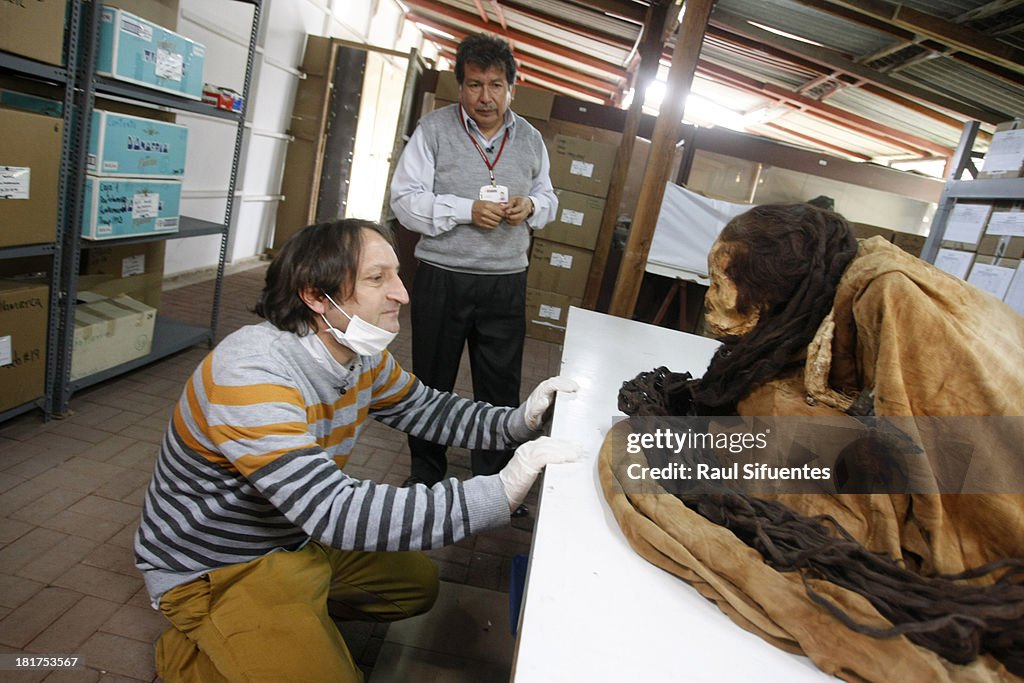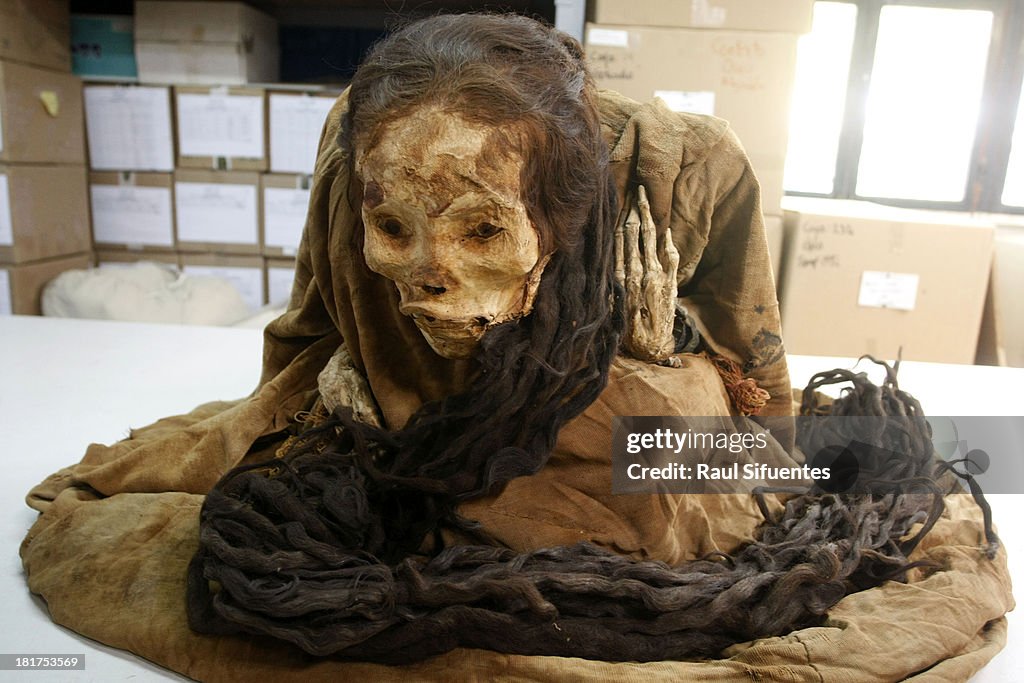The Huacas of Lima, Peru – Huaca Huallamarca
In the district of San Isidro we find the third Huaca for our series of articles. This site was developed and occupied from 200 BC – 200 AD by an unknown/unnamed culture. It is  theorized that they were Serrano (highlanders or from the mountains) who came down to occupy the fertile valleys of the Lima area. This Huaca is an imposing site. The same archaeologist that rebuilt the palace at Puruchuco, Arturo Jimenez Borja, reconstructed Huallamarca. Construction started on the site by the original people in 200 BC and it continued through 200 AD. The pyramid went through five phases of construction, which included five levels and two ramps
theorized that they were Serrano (highlanders or from the mountains) who came down to occupy the fertile valleys of the Lima area. This Huaca is an imposing site. The same archaeologist that rebuilt the palace at Puruchuco, Arturo Jimenez Borja, reconstructed Huallamarca. Construction started on the site by the original people in 200 BC and it continued through 200 AD. The pyramid went through five phases of construction, which included five levels and two ramps  leading up the pyramid. It was constructed entirely of mud bricks and adobe. When they decided to add to the pyramid, they merely added new levels over the top of the previous levels. Towards the end of its
leading up the pyramid. It was constructed entirely of mud bricks and adobe. When they decided to add to the pyramid, they merely added new levels over the top of the previous levels. Towards the end of its  period of use by the original builders, the middle platforms were reserved for the Administrative and elite leaders while the very top of the pyramid was reserved for the Shaman and the ceremonies that he performed there. The platform reserved for the administrator or Curaca was painted in yellow ochre of which small exposed samples survive to this day. Large ramps provided access to the different levels.
period of use by the original builders, the middle platforms were reserved for the Administrative and elite leaders while the very top of the pyramid was reserved for the Shaman and the ceremonies that he performed there. The platform reserved for the administrator or Curaca was painted in yellow ochre of which small exposed samples survive to this day. Large ramps provided access to the different levels.  The site was abandoned totally at approximately the same time that Huaca Pucllana came into prominence. The Lima Culture became the dominant force in this area during this time.
The site was abandoned totally at approximately the same time that Huaca Pucllana came into prominence. The Lima Culture became the dominant force in this area during this time.
The reconstruction has almost no resemblance to the original structure. The original pyramid was rounded with the ramps going up the sides and the orientation was slightly different. This shows why modern archaeologists think that there should not be any reconstruction at archaeological sites. The original structures must remain in pristine condition so that they can be studied in the future. The purpose in changing the way this pyramid looked has more to do with attracting tourists than demonstrating the way the original pyramid was built. Regardless, it is worth visiting.
 Many of the cultures that came into prominence in the area decided to use this site for burials, much the same as the previous two Huacas I visited. Both the Lima and Ichma Cultures used this site as a cemetery, burying the dead of their elite on the
Many of the cultures that came into prominence in the area decided to use this site for burials, much the same as the previous two Huacas I visited. Both the Lima and Ichma Cultures used this site as a cemetery, burying the dead of their elite on the  uppermost level of the pyramid. Tombs were discovered on the top platform reflecting both of these cultures and their funerary styles. The Lima Culture buried their dead in a standing position and the Ichma Culture buried their dead in bundles with funerary masks. When you tour the top of the pyramid you will see opened burial pits with exposed bones from unfinished excavations. The only culture that did not use this site as a cemetery was
uppermost level of the pyramid. Tombs were discovered on the top platform reflecting both of these cultures and their funerary styles. The Lima Culture buried their dead in a standing position and the Ichma Culture buried their dead in bundles with funerary masks. When you tour the top of the pyramid you will see opened burial pits with exposed bones from unfinished excavations. The only culture that did not use this site as a cemetery was  the Inca. They did consider the site sacred though and stationed people to live there on the lower platforms to protect the site. You can see excavations of their dwellings from the top of the pyramid. As with the other sites I have covered, much of the buildings surrounding this pyramid were
the Inca. They did consider the site sacred though and stationed people to live there on the lower platforms to protect the site. You can see excavations of their dwellings from the top of the pyramid. As with the other sites I have covered, much of the buildings surrounding this pyramid were  destroyed and covered with the movement of modern civilization into the area. Homes, roads and office buildings now cover unknown archaeological treasures.
destroyed and covered with the movement of modern civilization into the area. Homes, roads and office buildings now cover unknown archaeological treasures.

In the compound there are two nice museums. The first contains articles found during excavations of this site. There are ceramics from the Ichma, textiles from the Lima, and musical instruments and tools used for weaving.  There is also a mummy on display here; it is a woman of approximately 30 – 35 years of age who was a weaver. Weavers from the height of this culture were deemed of high status and her burial reflected that. There are also some funerary masks on display that were discovered with the Ichma burials. The second museum is dedicated to Arturo
There is also a mummy on display here; it is a woman of approximately 30 – 35 years of age who was a weaver. Weavers from the height of this culture were deemed of high status and her burial reflected that. There are also some funerary masks on display that were discovered with the Ichma burials. The second museum is dedicated to Arturo  Jimenez Borja and his work as an archaeologist in Peru in the 1960’s. It tells a little about this enigmatic man, his life, and his work along with a nice collection of photos of him and the sites he has worked on.
Jimenez Borja and his work as an archaeologist in Peru in the 1960’s. It tells a little about this enigmatic man, his life, and his work along with a nice collection of photos of him and the sites he has worked on.
They offer guided tours in English for S/.10 Soles and the adult price of admission is another S/.5 Soles. The site is open Tuesday through Sundays from 9am – 5pm. The address is Nicolas de Rivera 201 in San Isidro and the phone number is 222-4124.
Related Post
A shocking documentary proves that mermaids do exist
SHOCKING Revelation: Thuya, Mother of Queen Tiye, Was the Grandmother of Akhenaten and Tutankhamun—What Ancient Egyptian Secrets Did She Leave Behind?
Breaking News: Astonishing Discoveries at Karahan Tepe Confirm an Extraterrestrial Civilization is Hiding on Earth, and NO ONE Knows!
Breaking News: Researchers FINALLY Discover U.S. Navy Flight 19 After 75 Years Lost in the Bermuda Triangle!
NASA’s Secret Investigation: Uncovering the Astonishing Mystery of the UFO Crash on the Mountain!
Explosive UFO Docs LEAKED: Startling Proof That Aliens Ruled Ancient Egypt!


